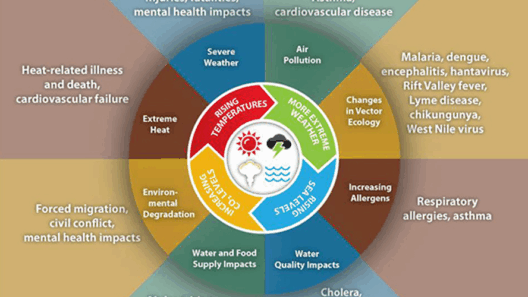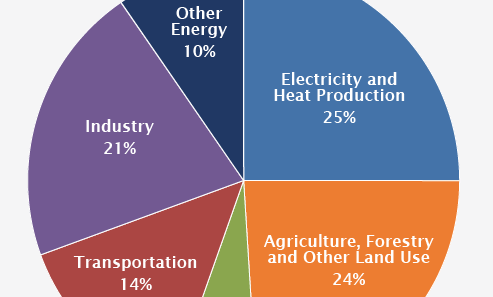Climate change is an existential crisis of unprecedented proportions, driven primarily by the cumulative effects of human activity. Understanding the fundamental sources of greenhouse gas emissions is critical to addressing this global challenge. This discourse aims to dissect the multifaceted contributors to climate change, offering insights into their implications and potential mitigation strategies.
At the core of climate change lies an increase in greenhouse gases (GHGs) in the Earth’s atmosphere. These gases—chiefly carbon dioxide (CO2), methane (CH4), and nitrous oxide (N2O)—trap heat, leading to a gradual rise in global temperatures. While numerous sectors contribute to the overall emission landscape, several key areas emerge as the largest culprits.
1. Energy Production
The energy sector stands as the paramount contributor to global greenhouse gas emissions. Power generation predominantly relies on fossil fuels—coal, oil, and natural gas—emitting vast quantities of CO2 during combustion. In 2020, the International Energy Agency reported that this sector accounted for approximately 40% of global CO2 emissions. Transitioning to renewable energy sources such as solar, wind, and hydropower is vital. These technologies not only mitigate emissions but also promote energy security and job creation in emerging sectors.
Moreover, energy consumption patterns skew heavily towards developed nations. Herein lies a stark inequality: less developed regions, despite contributing marginally to global emissions, grapple with the immediate effects of climate change exacerbated by the practices of more industrialized countries. Thus, energy production remains a critical fulcrum in the dialogue surrounding climate justice.
2. Transportation
The transportation sector is another significant emitter of GHGs. Vehicles powered by internal combustion engines release CO2 and other pollutants directly into the atmosphere. According to the U.S. Environmental Protection Agency (EPA), transportation accounted for nearly 29% of total GHG emissions in the United States in 2019. Cars, trucks, shipping, and aviation all contribute to this alarming statistic.
Decarbonizing transportation requires a multifaceted approach. Innovative solutions such as electric vehicles (EVs), improved public transit systems, and investments in infrastructure that supports cycling and walking can foster more sustainable urban environments. Furthermore, shifts in individual behavior, including carpooling and remote work arrangements, are practical steps that can helpto ameliorate emissions.
3. Agriculture
Agriculture, often overlooked in climate discussions, constitutes a significant portion of global emissions. Various practices, such as deforestation for pastureland, rice cultivation, and the use of synthetic fertilizers, contribute to large-scale methane and nitrous oxide emissions. Livestock farming is particularly notorious; ruminants like cattle produce methane during digestion, a gas with a global warming potential far exceeding that of CO2 over the short term.
To combat agricultural emissions, sustainable farming practices—including regenerative agriculture, crop diversity, agroforestry, and organic farming—present viable solutions. Re-envisioning our dietary choices, such as incorporating plant-based foods, can also play a pivotal role in reducing agricultural impacts on climate change.
4. Deforestation and Land Use Change
Forests are carbon sinks, capable of absorbing atmospheric CO2 through photosynthesis. However, deforestation for agricultural expansion, urbanization, and logging has led to a dramatic decline in forest cover globally. The World Resources Institute estimates that land-use change accounted for approximately 10% of annual GHG emissions. This loss not only exacerbates climate change by releasing stored carbon but also diminishes biodiversity and disrupts ecosystems.
Preserving existing forests and restoring degraded lands through reforestation and afforestation initiatives is paramount. Policies that protect native habitats and incentivize sustainable land management practices can curtail the environmental degradation currently inflicted by rampant deforestation.
5. Industrial Processes
Industrial activities, ranging from manufacturing to chemical production, contribute another significant proportion of GHGs. Cement production alone accounts for about 7% of global CO2 emissions. The sector’s energy-intensive processes and reliance on fossil fuels for power underpin its sizeable carbon footprint. Furthermore, some industrial activities release non-CO2 greenhouse gases, such as hydrofluorocarbons (HFCs), which are potent contributors to warming.
To counter industrial emissions, efficiency enhancements and innovative technologies such as carbon capture and storage (CCS) are crucial. Life cycle assessments of products can also help identify and mitigate emissions across entire supply chains, fostering a circular economy model where waste is minimized and resources are reused.
6. Waste Management
Waste management practices further compound climate change issues. Landfills, where organic waste decomposes anaerobically, emit significant amounts of methane, a potent greenhouse gas. Incineration, though reducing waste volume, can release CO2 and other pollutants if not managed sustainably.
Implementing more effective waste management strategies—such as recycling, composting, and reducing single-use plastics—is fundamental in mitigating emissions from the waste sector. Educating communities about sustainable waste practices can foster a culture of accountability and environmental responsibility.
Conclusion
Addressing climate change necessitates a holistic understanding of its contributors. The energy sector, transportation, agriculture, deforestation, industrial processes, and waste management all play pivotal roles in shaping the planet’s climatic future. A multifaceted approach that embraces innovation, sustainable practices, and equitable policy frameworks is paramount to curtail emissions and foster resilience against climate change’s effects. Individual actions, coupled with systemic transformations, will define the trajectory of climate action in the coming decades.





